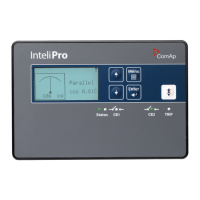InteliPro, SW version 1.0, ©ComAp – May 2011
InteliPro Application Guide
2-8
Protective functions in detail
Overvoltage, Undervoltage (ANSI 59, 27)
The RMS value of measured voltage is compared with the preset limit of overvoltage or undervoltage.
When any of the preset limits is over/underreached, the output U Sig moves to fault-indicating position
immediately. If the voltage of the given phase keeps out of limits for the delay of the appropriate stage,
TRIP is issued. As the voltage returns back within limits in all measured phases, the U Sig output stop
to signal the fault state immediately, regardless of whether TRIP was issued or not or Fault reset was
performed or not.
Both overvoltage and undervoltage protective stages provide possibility of setting 2 levels with
independent delay assigned to each level.
Overfrequency, Underfrequency (ANSI 81 H, L)
The frequency value measured on phase L1 is compared with the preset limit of overfrequency or
underfrequency. When any of the preset limits is over/underreached, the output f Sig moves to fault-
indicating position immediately. If the frequency keeps out of limits for the delay of the appropriate
stage, TRIP is issued. As the frequency returns back within limits, the f Sig output stops to signal the
fault state immediately, regardless of whether TRIP was issued or not or Fault reset was performed or
not.
Both overfrequency and underfrequency protective stages provide possibility of setting 2 levels with
independent delay assigned to each level.
Voltage unbalance (ANSI 47)
The voltage unballance is evaluated in case that amplitude difference between any 2 phases
overreaches the preset limit V Unb: V Unb. It refers to the amplitude unbalance of the measured
voltage.
"Loss of mains" protections
InteliPro provides two different methods for fast evaluation of loss of mains (LOM), into which the generator
operates:
- Vector shift
- Rate Of Change Of Frequency
The loss-of-mains protections setting is done using the setpoints in the group LOM.
Vector shift (ANSI 78)
Vector shift is one of the LOM protections. It provides very fast detection of mains failure (in units or
tens of ms), based on the principle of shift of the synchronous generator displacement angle. The
displacement angle is an angle between magnetic field of a rotor and the rotating magnetic field of the
stator winding and relates strongly to the load of the generator. In case that this load changes, the
displacement angle immediately changes by a "jump". Compared to the frequency decrease, which
probably also occurs, this jump is an immediate phenomena and is detected as a shift of the
measured voltage sine curve - Vector shift or Vector jump. Depending on the preset limit in degrees
[°], it allows immediate disconnection of very fast failures and thus prevention of severe damages
which could not be prevented within the delay of frequency or voltage protections.

